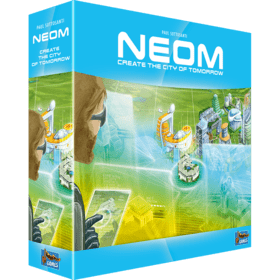Neom
 NEOM - 創建明日之城可讓您在三代人的時間內建造自己的未來城市。您需要選擇合適的建築瓷磚來創建美麗的住宅區、經濟商業和環保工業。建造你的城市會產生金錢和資源,可用於建造新的瓷磚並獲得勝利點數。每個城市都要求你留意它的結構,否則你會在遊戲結束時失分——沒有人喜歡住在核電站旁邊,對吧?
NEOM - 創建明日之城可讓您在三代人的時間內建造自己的未來城市。您需要選擇合適的建築瓷磚來創建美麗的住宅區、經濟商業和環保工業。建造你的城市會產生金錢和資源,可用於建造新的瓷磚並獲得勝利點數。每個城市都要求你留意它的結構,否則你會在遊戲結束時失分——沒有人喜歡住在核電站旁邊,對吧?
這只不過是 1 - 5 名 10 歲及以上建築師在 Paul Sottosantis NEOM - 創建明日之城中面臨的一項艱鉅任務。僅僅經過三代人的努力,一座新的城市就應該出現在他們的遊戲板上。為了做到這一點,他們每代起草 7 個建築瓷磚並將它們添加到他們的城市中。但他們必須小心,因為放置瓷磚需要規劃和策略。道路網絡必須具有功能性,住宅區和工業區不應相鄰放置,商業區如果不能從周圍環境中受益,其效率就會降低。大約 45 分鐘後,遊戲結束,一名玩家稱自己為建築師大師。
玩家人數: 1 - 5
遊戲歷時: 21 mn
複雜度 2 / 5
在線上玩 Neom 以及 1194 款其他遊戲。
無需下載──直接用你的網路瀏覽器玩。
與你的朋友以及全世界成千上萬的玩家們。
免費。

在線上玩 Neom 以及 1194 款其他遊戲。
無需下載──直接用你的網路瀏覽器玩。
與你的朋友以及全世界成千上萬的玩家們。
免費。

規則摘要
Game Objective
In Neom, you are building a futuristic city over a period of three generations by placing tiles in your city grid. These tiles provide various goods and money that you will need to place other tiles as well as victory points. Every city requires certain structures to be present or it will lose points during scoring. In the end, the player with the most victory points wins.
Course of Play
The game is played over three Generations (Rounds), preceded by a Preliminary Round, in which you will choose Cornerstone tiles for later use. Each Generation is comprised of seven turns, for a total of 21 turns over the course of the game. In each turn, you will select a tile and take one of three actions with it. After 21 of these turns, you will score your Cities and determine the winner.
Playing a Generation
The Generations are played in order, beginning with the 1st Generation, followed by the 2nd and then 3rd Generation. At the start of each Generation, take the corresponding Generation tiles and deal each player a hand of 8 tiles.
With this hand, play 7 turns as follows:
A. Select a Tile
B. Take an Action
C. Pick Up Tiles
The Generation ends after the 7th turn, in which you have a choice of 2 tiles in your hand. Then you receive income from the tiles in your City, before the next Generation is played in the same fashion. After receiving income at the end of the 3rd Generation, the game ends and scores are tallied.
A. Selecting a Tile
All players now simultaneously evaluate their hands of tiles, without showing them to the other players.
Select one tile. The other Tiles are passed to the left player at the end of turn.
B. Taking an Action
Normally, you can take one of the following three actions:
- Place the Selected Tile
- Place a Cornerstone Tile
- Sell the Tile for Money
ACTION: Placing the Selected Tile
To place the selected Generation tile, you must meet the requirements shown in the top left corner of the tile. If no requirement is shown, you can place the tile right away. If you cannot meet the requirement, you must choose a different action.
Place the Tile in your City according to the following rules:
- You must either place the tile on an empty space in your City grid or replace an existing tile. (See “Replacing an Existing Tile” for details.)
- The newly placed tile must be connected through Roads to the City Center (or the tile in its place, if you replaced your City Center). Roads do not have to connect with other Roads necessarily, as long as there is at least one Road connection leading to the City Center.
- You may not rotate the tile. All tiles must be placed such that you can read their names upright.
ACTION: Placing a Cornerstone Tile
Cornerstone tiles are much like Generation tiles. To place a Cornerstone tile, you must return the selected Generation tile to the game box, unused. Then choose one of your remaining Cornerstone tiles and place it in your City, as detailed in “Placing the Selected Tile”. (The placement rules apply to both Generation and Cornerstone tiles.)
Important! You cannot have more Cornerstone tiles in your City than the current Generation!
Reminder: You cannot discard a Disaster tile to place a Cornerstone tile!
ACTION: Selling the Tile for Money
Instead of placing a Generation or Cornerstone tile, you can simply return the selected Generation tile to the game box, unused, and take 5 L-Coins from the general supply. (Usually, this is a desperation move if you are short on money.)
END OF TURN: Resolving a Disaster
If a Disaster is selected by a player, it activates a negative effect for all other players at the end of the current turn (after all other players have taken their action), causing them to lose money or tiles in their City. Selecting the Disaster protects you from its effect but you do not get to take an action that turn.
Note: If no player selects the Disaster in a given Generation, it will not happen.
Players can protect their tiles from the Fire and Crime Spree penalty by building certain Public tiles in their City. (There is no protection from Flood.) Protected tiles are not counted when calculating how much money you must pay for the Disaster. Tiles are never protected from removal, especially if you choose to sacrifice tiles instead of paying the penalty.
C. Picking Up Tiles
Pick up the tiles passed to you, in step A, by the player to your right. This is your hand for the following turn. If there are no tiles to pick up, you have completed the current Generation.
END OF GENERATION: Collecting Income
At the end of each Generation, after 7 turns have been played, players collect income from their Commercial (and other) tiles that show the income symbol.
Important! Even though the game ends after three Generations, players do collect income even at the end of the 3rd Generation!
Game End and Scoring
The game ends after you collect your final income at the end of the 3rd Generation.
You score Victory Points (VP) in the following categories:
Tiles
Add up the Victory Point values on the (Residential and Public) tiles in your City, as printed in the top right corner of the tiles.
Neighborhoods
Residential tiles automatically form Neighborhoods by themselves or with other Residential tiles, if they are directly connected by Roads. The value of a Neighborhood depends on its size, i.e., the number of Residential tiles in the Neighborhood.
| Size | 1 | 2 | 3 | 4 | 5 | 6 | 7 | 8 | 9 | 10 | ... |
| VP | 1 | 3 | 6 | 10 | 15 | 21 | 28 | 36 | 40 | 44 | ... |
Each tile beyond the 8th increases the value of its Neighborhood by a constant 4 VP.
Goods
As shown at the top of your City board, each Raw Good is worth 1 VP, each Processed Good 2 VP, and each Luxury Good 10 VP. Each Good is scored only once, regardless of how many tiles in your City show that Good. (In other words, only score the Good tokens above your City board.)
Money
Score 1 VP for every £2 you have left, rounded down. (This is why you receive income at the end of the 3rd Generation.)
Pollution
For each Residential tile in your City, check whether it is nearby one or more Polluting tiles. You lose 2 VP for each orthogonally adjacent and 1 VP for each diagonally adjacent Polluting tile. (You can lose points for the same Polluting tile more than once, if it is nearby multiple Residential tiles.)
Ghost Town
You lose 10 VP if you do not have any Residential tiles in your City. You lose 4 VP if you have only 1 Residential tile.
Power
You lose 5 VP if you do not have at least one Power-generating tile in your City
Final Score
Total these values to determine your final score. The player with the most Victory Points wins. In case of a tie, enjoy your shared victory!
Game variant: No disasters [1]
Disasters are replaced with city tiles. Insurance Office is removed.
Updated victory points:
- Fire Department: +2 VP
- Police Department: +3 VP
- Public Safety Department: +5 VP
Game variant: Random disasters [2]
Disasters are replaced with city tiles.
Each disaster is randomly triggered within the respective generation, affecting all players equally.
Solo Game
Scoring Table
| Tiles | Intern | Apprentice | Fellow | Foreman | Master | Boss |
|---|---|---|---|---|---|---|
| 1+ | 0-79 | 80-99 | 100-109 | 110-119 | 120-124 | 125+ |
| 4+ | 0-84 | 85-104 | 105-114 | 115-124 | 125-129 | 130+ |
| 5+ | 0-89 | 90-109 | 110-119 | 120-129 | 130-134 | 135+ |

